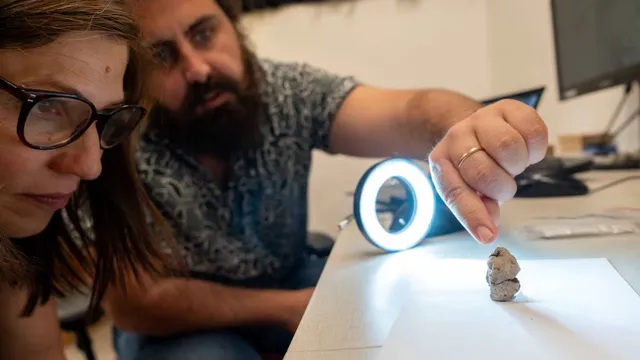- By Supratik Das
- Tue, 18 Nov 2025 03:54 PM (IST)
- Source:JND
Archaeologists in northern Israel have uncovered a 12,000-year-old clay figurine that is reshaping understanding of early symbolic life in Southwest Asia. The small sculpture depicting a crouching woman with a goose poised on her back was recovered at Nahal Ein Gev II, a Late Natufian village overlooking the Sea of Galilee.
Researchers describe it as one of the world’s oldest renderings of a mythological scene and the earliest-known figurine showing direct human–animal interaction. Published in the Proceedings of the National Academy of Sciences (PNAS), the study led by Dr. Laurent Davin of the Hebrew University of Jerusalem highlights the figurine’s remarkable craftsmanship and cultural significance.
Naturalistic Style Marks Break From Earlier Art Traditions
Just 3.7 cm tall, the figurine was shaped from local clay, dried and then fired at approximately 400°C, which indicates controlled pyrotechnology in the period. Microscopic analysis revealed red ocher pigment on both figures and even a preserved fingerprint, likely belonging to the artisan who modelled it.
What stands out is the naturalistic form. The goose, wings spread in an active stance, appears alive rather than symbolic prey. This, researchers say, marks a shift away from the stylised art more commonly associated with the Natufian period.

Mythic Encounter Rooted In Animistic Beliefs
Prof. Leore Grosman, co-author of the study, said the scene likely reflects an imagined or spiritual interaction rather than a literal one. In animistic cultures, humans, animals, and natural elements were believed to share a spiritual essence. “Such scenes point to ideas around fertility, transformation, and the fluid boundaries between human and animal worlds,” she said.
The figurine was unearthed within the fill of a semicircular stone structure nearly five metres in diameter. The space also contained human teeth, the remains of a child, and ritual items, suggesting ceremonial rather than domestic use. Faunal evidence from the site shows geese played symbolic roles, including ornamentation and ritual feather use.
Prof. Natalie Munro of the University of Connecticut noted that the figurine challenges existing assumptions about when complex storytelling emerged. “This shows that long before agriculture, settled foragers were already expressing layered mythic ideas,” she said.
Thus, the Natufian culture, which spanned roughly 15,000 to 11,500 years ago, represents a turning point in human history as communities shifted from nomadic foraging to sedentary life. Researchers say that the transition also spurred new forms of symbolic and artistic expression.
With inputs from agency.
